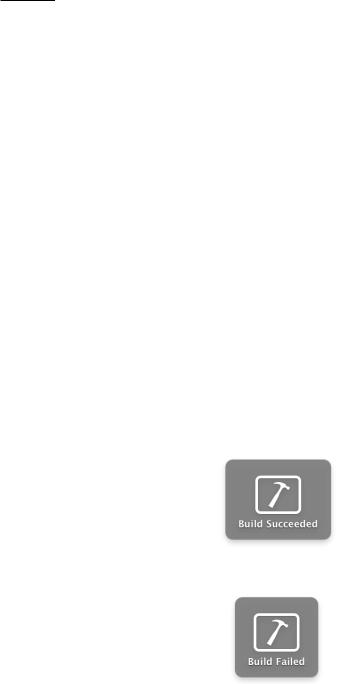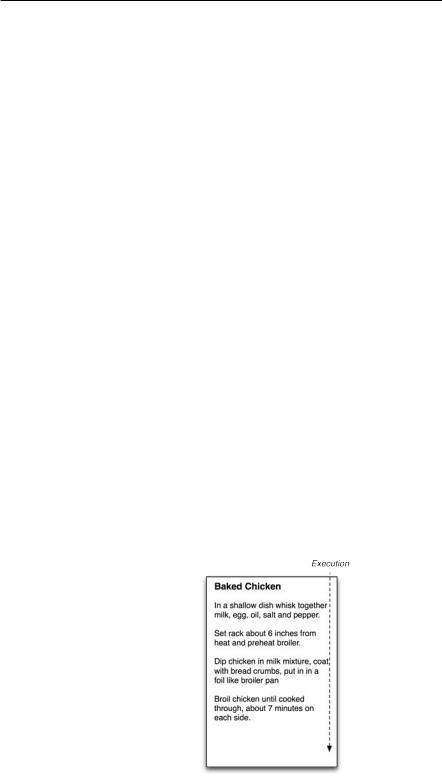
- •C and Objective-C
- •How this book works
- •How the life of a programmer works
- •Installing Apple’s developer tools
- •Getting started with Xcode
- •Where do I start writing code?
- •How do I run my program?
- •So what is a program?
- •Don’t stop
- •Types
- •A program with variables
- •Challenge
- •Boolean variables
- •When should I use a function?
- •How do I write and use a function?
- •How functions work together
- •Local variables, frames, and the stack
- •Recursion
- •Looking at the frames in the debugger
- •return
- •Global and static variables
- •Challenge
- •printf()
- •Integer operations
- •Integer division
- •Operator shorthand
- •Floating-point numbers
- •Tokens for displaying floating-point numbers
- •The while loop
- •The for loop
- •break
- •continue
- •The do-while loop
- •Challenge
- •Getting addresses
- •Storing addresses in pointers
- •Getting the data at an address
- •How many bytes?
- •NULL
- •Stylish pointer declarations
- •Challenges
- •Writing pass-by-reference functions
- •Avoid dereferencing NULL
- •Creating and using your first object
- •Message anatomy
- •Objects in memory
- •Challenge
- •Nesting message sends
- •Multiple arguments
- •Sending messages to nil
- •Challenge
- •Challenge
- •NSMutableArray
- •Reference pages
- •Quick Help
- •Other options and resources
- •Accessor methods
- •Dot notation
- •Properties
- •self
- •Multiple files
- •Challenge
- •Overriding methods
- •super
- •Challenge
- •Object ownership and ARC
- •Creating the Asset class
- •Adding a to-many relationship to Employee
- •Challenge
- •Retain cycles
- •Weak references
- •Zeroing of weak references
- •For the More Curious: Manual reference counting and ARC History
- •Retain count rules
- •NSArray/NSMutableArray
- •Immutable objects
- •Sorting
- •Filtering
- •NSSet/NSMutableSet
- •NSDictionary/NSMutableDictionary
- •Preprocessor directives
- •#include and #import
- •#define
- •Global variables
- •enum
- •#define vs global variables
- •Writing an NSString to a file
- •Reading files with NSString
- •Writing an NSData object to a file
- •Reading an NSData from a file
- •Target-action
- •Helper objects
- •Notifications
- •Which to use?
- •Callbacks and object ownership
- •Challenge
- •Getting started with iTahDoodle
- •BNRAppDelegate
- •Adding a C helper function
- •Objects in iTahDoodle
- •Model-View-Controller
- •The application delegate
- •Setting up views
- •Running on the iOS simulator
- •Wiring up the table view
- •Adding new tasks
- •Saving task data
- •For the More Curious: What about main()?
- •Edit BNRDocument.h
- •A look at Interface Builder
- •Edit BNRDocument.xib
- •Making connections
- •Revisiting MVC
- •Edit BNRDocument.m
- •Writing init methods
- •A basic init method
- •Using accessors
- •init methods that take arguments
- •Deadly init methods
- •Property attributes
- •Mutability
- •Lifetime specifiers
- •copy
- •More about copying
- •Advice on atomic vs. nonatomic
- •Key-value coding
- •Non-object types
- •Defining blocks
- •Using blocks
- •Declaring a block variable
- •Assigning a block
- •Passing in a block
- •typedef
- •Return values
- •Memory management
- •The block-based future
- •Challenges
- •Anonymous block
- •NSNotificationCenter
- •Bitwise-OR
- •Bitwise-AND
- •Other bitwise operators
- •Exclusive OR
- •Complement
- •Left-shift
- •Right-shift
- •Using enum to define bit masks
- •More bytes
- •Challenge
- •char
- •char *
- •String literals
- •Converting to and from NSString
- •Next Steps
- •Index

How do I run my program?
These color differences are just one way in which Xcode lets you know when you (may) have done something wrong.
How do I run my program?
When the contents of your main.c file match what you see above, it’s time to run your program and see what it does. This is a two-step process. Xcode builds your program and then runs it. When building your program, Xcode prepares your code to run. This includes checking for syntax and other kinds of errors.
Look again at the lefthand area of the Xcode window. This area is called the navigator area. At the top of the navigator area is a series of buttons. You are currently viewing the project navigator, which shows you the files in your project. The project navigator’s icon is  .
.
Now find and click the  button to reveal the log navigator. The log is Xcode’s way of communicating with you when it is building and running your program.
button to reveal the log navigator. The log is Xcode’s way of communicating with you when it is building and running your program.
You can also use the log for your own purposes. For instance, the line in your code that reads
printf("It was the best of times.\n");
is an instruction to display the words “It was the best of times.” in the log.
Since you haven’t built and run your program yet, there isn’t anything in the log navigator. Let’s fix that. In the upper lefthand corner of the project window, find the button that looks suspiciously like the Play button in iTunes or on a DVD player. If you leave your cursor over that button, you’ll see a tool tip that says Build and then run the current scheme. That is Xcode-speak for “Press this button, and I will build and run your program.”
If all goes well, you’ll be rewarded with the following:
If not, you’ll get this:
What do you do then? Carefully compare your code with the code in the book. Look for typos and missing semicolons. Xcode will highlight the lines it thinks are problematic. After you find the problem, click the Run button again. Repeat until you have a successful build.
(Don’t get disheartened when you have failed builds with this code or with any code you write in the future. Making and fixing mistakes helps you understand what you’re doing. In fact, it’s actually better than lucking out and getting it right the first time.)
13

Chapter 2 Your First Program
Once your build has succeeded, find the item at the top of the log navigator labeled Debug AGoodStart. Click this item to display the log from the most recent run of your program.
The log can be quite verbose. The important part is the Dickens quote at the end. That’s your code being executed!
GNU gdb 6.3.50-20050815 (Apple version gdb-1705) (Tue Jul 5 07:36:45 UTC 2011) Copyright 2004 Free Software Foundation, Inc.
GDB is free software, covered by the GNU General Public License, and you are welcome to change it and/or distribute copies of it under certain conditions. Type "show copying" to see the conditions.
There is absolutely no warranty for GDB. Type "show warranty" for details. This GDB was configured as "x86_64-apple-darwin".tty /dev/ttys001 [Switching to process 2723 thread 0x0]
It was the best of times. It was the worst of times.
(As I’m writing this, Apple is working on a new debugger called LLDB. Eventually it will replace GDB, the current debugger. If you aren’t seeing all the GDB information, it means that LLDB is now Xcode’s standard debugger. The future must be a terrific place; I envy you.)
So what is a program?
Now that you’ve built and run your program, let’s take a look inside. A program is a collection of functions. A function is a list of operations for the processor to execute. Every function has a name, and the function that you just wrote is named main. There was also another function – printf. You didn’t write this function, but you did use it. (We’ll find out where printf comes from in Chapter 5.)
To a programmer, writing a function is a lot like writing a recipe: “Stir a quart of water slowly until it boils. Then mix in a cup of flour. Serve while hot.”
In the mid-1970’s, Betty Crocker started selling a box containing a set of recipe cards. A recipe card is a pretty good metaphor for a function. Like a function, each card has a name and a set of instructions. The difference is that you execute a recipe, and the computer executes a function.
Figure 2.5 A recipe card named Baked Chicken
14

Don’t stop
Betty Crocker’s cooking instructions are in English. In the first part of this book, your functions will be written in the C programming language. However, a computer processor expects its instructions in machine code. How do we get there?
When you write a program in C (which is relatively pleasant for you), the compiler converts your program’s functions into machine code (which is pleasant and efficient for the processor). The compiler is itself a program that is run by Xcode when you press the Run button. Compiling a program is the same as building a program, and we’ll use these terms interchangeably.
When you run a program, the compiled functions are copied from the hard drive into memory, and the function called main is executed by the processor. The main function usually calls other functions. For example, your main function called the printf function. (We’ll see more about how functions interact in Chapter 5.)
Don’t stop
At this point, you’ve probably dealt with several frustrations: installation problems, typos, and lots of new vocabulary. And maybe nothing you’ve done so far makes any sense. That is completely normal.
As I write this, my son Otto is six. Otto is baffled several times a day. He is constantly trying to absorb knowledge that doesn’t fit into his existing mental scaffolding. Bafflement happens so frequently, that it doesn’t really bother him. He never stops to wonder, “Why is this so confusing? Should I throw this book away?”
As we get older, we are baffled much less often – not because we know everything, but because we tend to steer away from things that leave us bewildered. For example, reading a book on history is quite pleasant because we get nuggets of knowledge that we can hang from our existing mental scaffolding. This is easy learning.
Learning a new language is an example of difficult learning. You know that there are millions of people who work in that language effortlessly, but it seems incredibly strange and awkward in your mouth. And when people speak it to you, you are often flummoxed.
Learning to program a computer is also difficult learning. You will be baffled from time to time – especially here at the beginning. This is fine. In fact, it’s kind of cool. It is a little like being six again.
Stick with this book; I promise that the bewilderment will cease before you get to the final page.
15
This page intentionally left blank
Part II
How Programming Works
In these next chapters, you will create many programs that demonstrate useful concepts. These command-line programs are nothing that you’ll show off to your friends, but there should be a small thrill of mastery when you run them. You’re moving from computer user to computer programmer.
Your programs in these chapters will be written in C. Note that these chapters are not intended to cover the C language in detail. Quite the opposite: honed from years of teaching, this is the essential subset of what new-to-programming people need to know about programming and programming in C before learning Objective-C programming.
This page intentionally left blank
